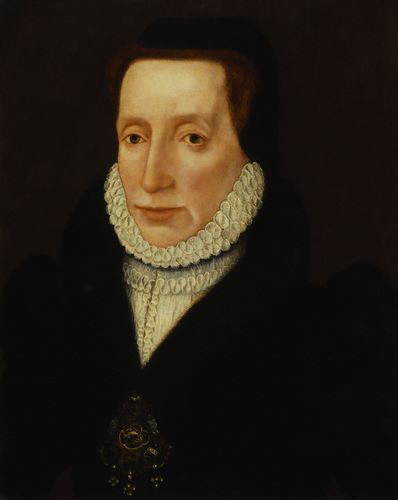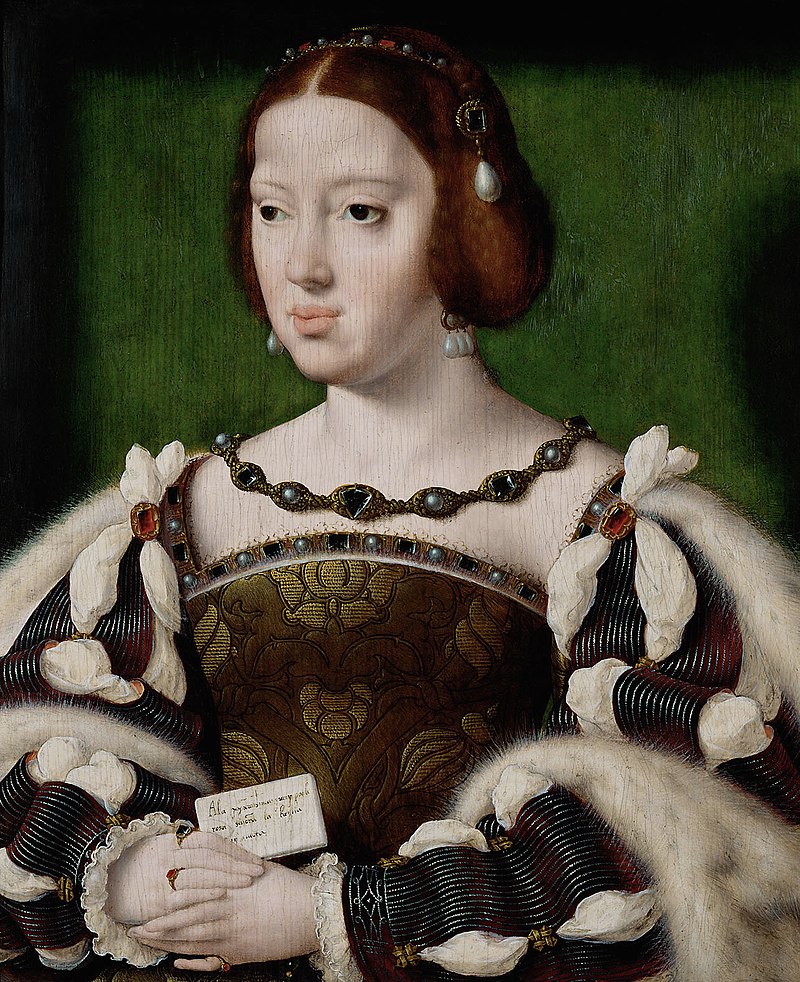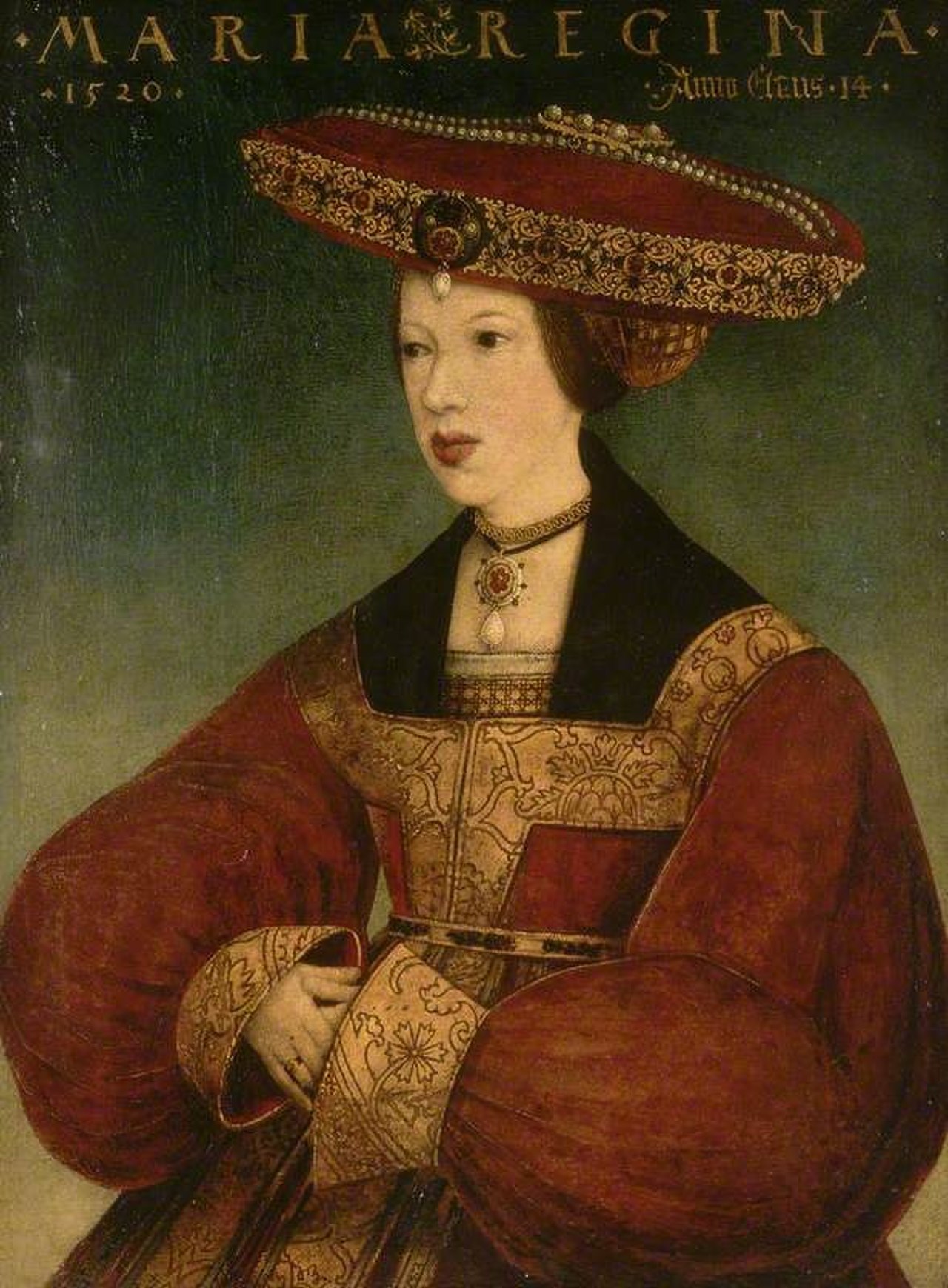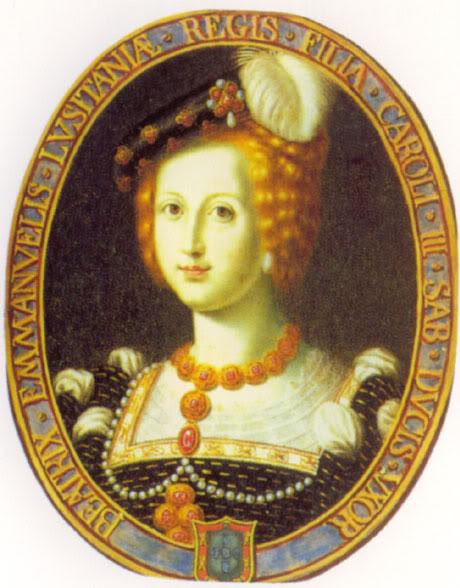by Susan Flantzer
© Unofficial Royalty 2019

Queen Mary of England (1516 – 1558)
(All photos credits – Wikipedia unless otherwise noted)
Mary was the only child of King Henry VIII of England and his first of six wives, Catherine of Aragon, to survive infancy. Her paternal grandparents were King Henry VII of England and Elizabeth of York, the eldest child of King Edward IV of England and Elizabeth Woodville. Mary’s maternal grandparents The Catholic Monarchs, King Ferdinand II of Aragon and Queen Isabella I of Castile.
Mary was well educated and studied Greek, Latin, French, Italian, science, and music but her father was disappointed that Mary was not a male. By the time Mary’s mother Catherine of Aragon turned 40, it was very unlikely that she would produce the male heir that Henry yearned for. Ultimately, Henry broke with the Vatican, formed the Church of England and had his marriage with Catherine declared null and void. Catherine was banished from the court and was forbidden to see her daughter Mary. Mary was forced into acknowledging, at least outwardly, that her father was the Head of the Church of England but throughout her life, Mary remained true to the Roman Catholic Church.
Through the influence of Catherine Parr, Henry VIII’s sixth and final wife, the family was drawn closer together. Catherine Parr was influential in Henry’s passing of the Third Succession Act in 1543 which restored both his daughters, Mary and Elizabeth to the line of succession to the throne. King Henry VIII died in 1547 and was succeeded by his 9-year-old son as King Edward VI. Henry’s three children remained on friendly terms despite their great differences in age and religious belief.
As 15-year-old King Edward VI lay dying, probably of tuberculosis, many feared that Edward VI’s death and the succession of his Catholic half-sister Mary would spell trouble for the English Reformation. Edward opposed his half-sister Mary’s succession not only for religious reasons but also because he believed her to be illegitimate and his belief in male succession. He also opposed the succession of his half-sister Elizabeth for reasons of illegitimacy and belief in male succession. King Edward VI composed a document “My devise for the succession” in which he passed over his half-sisters and his cousin Frances Brandon, the daughter of Mary Tudor. Edward meant for the throne to go to Frances’ daughters and their male heirs. After great suffering, fifteen-year-old King Edward VI died and Frances’ eldest daughter Lady Jane Grey was told that she was queen, and reluctantly accepted the fact. Jane’s reign lasted only nine days. Henry VIII’s elder daughter and Jane’s first cousin Mary gathered an army and marched on London. In the aftermath, among those executed were Frances’ husband, her daughter Jane, and Jane’s husband Guilford Dudley.
Mary was 37, and it was vital that she marry and produce a Catholic heir to supplant her Protestant sister Elizabeth. Mary married Philip of Spain (later King Philip II of Spain), the only son of Mary’s first cousin Charles V, Holy Roman Emperor. Philip was eleven years younger than Mary and he found her repugnant. Mary had a phantom pregnancy, Philip came and went from England and finally left for good after three years of marriage.
Throughout her reign, Mary was steadfast in her determination to restore the Roman Catholic religion to England. During Mary’s reign, nearly 300 Protestants were burned at the stake for heresy. Included in this number were the famous three Oxford Martyrs: Thomas Cranmer, Archbishop of Canterbury; Hugh Latimer, Bishop of Worcester; and Nicholas Ridley, Bishop of London.
Mary shared her paternal first cousins with her half-siblings Queen Elizabeth I of England, who succeeded her, and King Edward VI of England.
********************
Paternal Aunts and Uncles of Queen Mary I of England: Children of King Henry VII of England and Elizabeth of York
- Arthur, Prince of Wales (1486 – 1502), married Catherine of Aragon, no children
- Margaret Tudor, Queen of Scots (1489 – 1541), married (1) James IV, King of Scotland, had four sons bot the only surviving one was King James V of Scotland; (2) Archibald Douglas, 6th Earl of Angus, had one daughter; (3) Henry Stewart, 1st Lord Methven, no surviving children
- Elizabeth Tudor (1492 – 1495), died in childhood
- Mary Tudor, Queen of France, Duchess of Suffolk (1496 – 1533), married (1) Louis XII, King of France, no children; (2) Charles Brandon, 1st Duke of Suffolk, had two sons and two daughters
- Edmund Tudor, Duke of Somerset (1499 – 1500), died in infancy
- Katherine Tudor (born and died February 1503), her mother Elizabeth of York died as a result of Katherine’s birth
********************
Maternal Aunts and Uncles of Queen Mary I of England: Children of King Ferdinand II of Aragon and Queen Isabella I of Castile
- Isabella of Aragon, Queen of Portugal (1470 – 1498), married (1) Prince Afonso of Portugal, no children (2) King Manuel I of Portugal, had one son
- Juan, Prince of Asturias (1478 – 1497), married Margaret of Austria, no children
- Juana I, Queen of Castile, Queen of Aragon (1479 – 1555), married Philip of Habsburg, son of Holy Roman Emperor Maximilian I and Mary, Duchess of Burgundy; had four daughters and two sons, all of whom were kings/emperors or queen consorts
- Maria of Aragon, Queen of Portugal (1482–1517), married King Manuel I of Portugal, widower of her elder sister Isabella; had six sons and two daughters
********************
PATERNAL FIRST COUSINS
Paternal First Cousins of Queen Mary I of England: Children of Margaret Tudor and James IV, King of Scotland
James, Duke of Rothesay (1507 – 1508)
James was born at Holyrood Palace in Edinburgh, Scotland. He was styled Duke of Rothesay, the title held by the eldest son of the King of Scots who is also the heir apparent. James died at Stirling Castle in Stirling, Scotland six days after his first birthday.
*********************
Arthur, Duke of Rothesay (1509 – 1510)
Arthur was born at Holyrood Palace in Edinburgh, Scotland. As his elder brother had died, he was the eldest son of the King of Scots and the heir apparent, so he was styled Duke of Rothesay. He died when he was eight months old at Edinburgh Castle in Edinburgh, Scotland.
*********************

James V, King of Scots (1512 – 1542)
Born at Linlithgow Palace in Linlithgowshire, Scotland, at his birth, James became Duke of Rothesay, the traditional title of the eldest son of the King of Scots as his two elder brothers James and Arthur had died in infancy. His 30-year-old father James IV was killed at the Battle of Flodden and 17-month-old James succeeded his father as James V, King of Scots.
James married 16-year-old Madeleine of Valois, daughter of King François I of France. Madeleine, who was sickly since her birth, had developed tuberculosis. Six months after the wedding and just two months after arriving in Scotland, Madeleine died. Less than a year after the death of his first wife, James V married again to Marie of Guise, the eldest daughter of Claude of Lorraine, Duke of Guise, head of the House of Guise. James V and Marie had two sons and one daughter, but their sons died in infancy.
After a disastrous defeat of the Scots army by the English army at the Battle of Solway Moss, James V fled to Falkland Palace in Fife, Scotland where he became ill and took to his bed. Overcome with grief and shame about the Battle of Solway Moss, James V lost the will to live. The news that Marie of Guise had given birth to a daughter did nothing to raise his spirits. 30-year-old James V, King of Scots died and was succeeded by his only surviving, legitimate child, six-day-old Mary, Queen of Scots.
*********************
Alexander, Duke of Ross (1514 – 1515)
Alexander was born at Holyrood Palace in Edinburgh, Scotland, seven months after the death of his father King James IV at the Battle of Flodden. He died four months short of his second birthday at Stirling Castle in Stirling, Scotland.
*********************
Paternal First Cousins of Queen Mary I of England: Child of Margaret Tudor and her second husband Archibald Douglas, 6th Earl of Angus

Lady Margaret Douglas, Countess of Lennox (1515 – 1578)
Margaret was the only child of Margaret Tudor and the second of her three husbands, Archibald Douglas, 6th Earl of Angus. Prior to her birth, Margaret’s parents left Scotland for England because of difficulties her father was having in Scotland, and so, Margaret was born in England. She was brought up in England with her cousin Mary, the future Queen Mary I. The two cousins remained close to each other their whole lives. Margaret married a Scottish exile, Matthew Stewart, 4th Earl of Lennox. The couple had several children but only two sons survived childhood. Their elder son Henry Stuart, Lord Darnley was the second of the three husbands of his first cousin Mary, Queen of Scots. Their only child was James VI, King of Scots who succeeded Queen Elizabeth I of England as James I, King of England. Through her grandson King James I, Margaret is an ancestor of the British royal family and many other European royal families. When Margaret died, she was given a grand funeral by her cousin Queen Elizabeth I and was buried at Westminster Abbey where a beautiful tomb was erected, most likely by her grandson King James I, in the same chapel where James later erected a tomb for his mother Mary, Queen of Scots.
*********************
Paternal First Cousins of Queen Mary I of England: Children of Mary Tudor and Charles Brandon, 1st Duke of Suffolk
Henry Brandon (1516 – 1522), died in childhood
*********************

Lady Frances Brandon, Duchess of Suffolk (1517 – 1559)
Although Frances and her siblings were only the children of a duke, they had their mother’s royal blood. They were the grandchildren of King Henry VII of England and the nieces and nephews of King Henry VIII of England, and therefore had claims to the English throne. Frances married Henry Grey, 3rd Marquess of Dorset, later Duke of Suffolk. They had a son and a daughter who both died young and then had three daughters including Lady Jane Grey. As the niece of King Henry VIII, Frances was one of the highest-ranking women at court and often took on ceremonial duties. When Henry VIII died, his only son and Frances’ first cousin, succeeded him as King Edward VI.
Edward VI was sickly and probably had tuberculosis. His reign would only last six years. Edward VI’s death and the succession of his Catholic half-sister Mary would spell trouble for the English Reformation. Edward opposed his half-sister Mary’s succession not only for religious reasons but also because he believed her to be illegitimate and his belief in male succession. He also opposed the succession of his half-sister Elizabeth for reasons of illegitimacy and belief in male succession. King Edward VI composed a document “My devise for the succession” in which he passed over his half-sisters and Frances. Edward meant for the throne to go to the Frances’ daughters and their male heirs. After great suffering, fifteen-year-old King Edward VI died and Frances’ eldest daughter Lady Jane Grey was told that she was queen, and reluctantly accepted the fact. Jane’s reign lasted only nine days. Henry VIII’s elder daughter and Jane’s first cousin Mary gathered an army and marched on London. In the aftermath, among those executed were Frances’ husband, her daughter Jane, and Jane’s husband Lord Guildford Dudley.
Frances’ life was now in ruins. Because her husband was a traitor, all his possessions reverted to the Crown. Frances managed to plead with her cousin Queen Mary I to show mercy. Mary agreed that some of the Duke of Suffolk’s property could remain with the family. Frances married her Master of the Horse Adrian Stokes and they had two stillborn children and a daughter who died in infancy. Frances, aged 42, died during the reign of her first cousin Queen Elizabeth I who paid the cost of her funeral. She was buried at Westminster Abbey. Four years later, her widower Adrian Stokes had a beautiful tomb and effigy placed over her grave.
*********************

Portrait of either Lady Eleanor or her daughter Lady Margaret
Lady Eleanor Brandon, Countess of Cumberland (1519 – 1547)
Eleanor married Henry Clifford, 2nd Earl of Cumberland. Eleanor’s uncle King Henry VIII attended her wedding. Eleanor and her husband had two sons who did not survive infancy and one daughter Lady Margaret Clifford. Eleanor received the honor of being chief mourner at the funeral of Catherine of Aragon, Henry VIII’s first wife.
*********************

Henry Brandon, 1st Earl of Lincoln (circa 1523 – 1534)
Henry was created Earl of Lincoln by his uncle Henry VIII when he was two-years-old. He died when he was ten or eleven years old.
********************
MATERNAL FIRST COUSINS
Maternal First Cousins of Queen Mary I of England: Child of Isabella of Aragon, Princess of Asturias, Queen of Portugal and King Manuel I of Portugal
Miguel da Paz, Prince of Portugal and Prince of Asturias (1498 – 1500)
Miguel’s mother, who was the heir presumptive to the thrones of Castile and Aragon, died giving birth to him. During his short life, he was heir to the thrones of Portugal, Castile, and Aragon and there were dreams of uniting the Iberian Peninsula into one kingdom. He died in the arms of his maternal grandmother Queen Isabella I of Castile, one month short of his second birthday. He was buried at the Capilla Real in Granada, where his maternal grandparents were also eventually buried.
********************
Maternal First Cousins of Queen Mary I of England: Children of Juana I, Queen of Castile, Queen of Aragon and Philip of Habsburg (Philip I of Castile)

Eleanor of Austria, Queen of Portugal, Queen of France (1498 – 1558)
Eleanor was the third wife of King Manuel of Portugal who had been previously married to two of Eleanor’s maternal aunts. They had one son who died in infancy and one daughter. Three years after her marriage, Eleanor became a widow when her husband died of the plague. She made a second marriage to King François I of France but the couple had no children. Eleanor’s second marriage was not really a happy one as François preferred his mistresses. However, she helped raise François’ daughters from his first marriage. After François’s death, Eleanor lived in Brussels with her brother Charles V, Holy Roman Emperor. After Charles’ abdication, Charles and Eleanor went to their homeland of Spain where they spent the rest of their lives.
********************

Charles V, Holy Roman Emperor (1500 – 1558)
Charles was the heir of three of Europe’s leading dynasties: Valois of Burgundy, Habsburg of Austria, and Trastámara of Spain. He was the first to rule a unified Spain. As a Habsburg, he inherited Austria and other lands in central Europe and was also elected to succeed his grandfather Maximilian I as Holy Roman Emperor. Charles was Holy Roman Emperor, King of Spain (Castile and Aragon), and Prince of the Habsburg Netherlands as Duke of Burgundy. He ruled over a large territory in Europe including the Holy Roman Empire extending from Germany to northern Italy with direct rule over the Low Countries and Austria, and a unified Spain with its southern Italian kingdoms of Naples, Sicily, and Sardinia.
Charles married his maternal first cousin Isabella of Portugal and they had seven children but only three survived childhood including Philip II who succeeded his father as King of Spain.
Physically exhausted after forty years of ruling, Charles abdicated and retired to the peace of the Monastery of Yuste in Extremadura, Spain, where he died three years later. Upon Charles’s abdications, the Holy Roman Empire was inherited by his younger brother Ferdinand, who had previously been given the Austrian lands. The Spanish Empire, including the possessions in the Netherlands and Italy, was inherited by Philip, Charles’ son.
********************

Isabella of Austria, Queen of Denmark (1501 – 1526)
Isabella married King Christian II of Denmark. They had three sons and two daughters but only their daughters survived to adulthood. After a reign of ten years, Christian II was forced by disloyal nobles to abdicate and his uncle succeeded him as King Frederik I. Christian and his family were exiled to the Netherlands, ruled by his brother-in-law, Holy Roman Emperor Charles V. When Isabella visited Brandenburg (now in Germany), she became interested in the teachings of Martin Luther. Although she never officially converted, Isabella received communion in Protestant rites and sympathized with Protestants. Isabella died at the age of 25 after an illness. Her fifteenth-generation great-granddaughter, Princess Isabella of Denmark, was named after her.
********************

Ferdinand I, Holy Roman Emperor (1503 – 1564)
Ferdinand was Holy Roman Emperor, King of Bohemia, King Hungary and King of Croatia. During his reign, the Ottoman Empire began its advance into Central Europe, and the Protestant Reformation began. He married Anna of Bohemia and Hungary and they had eleven daughters and four sons. Only two of their children did not survive childhood.
********************

Mary of Austria, Queen of Hungary and Bohemia (1505 – 1558)
At the age of ten, Mary married King Ludovik II of Hungary and Bohemia. By the time she was 21-years-old, Mary was a childless widow, her husband having died in battle. Mary then governed Hungary as regent in the name of the new king, her brother Ferdinand. After the death of her aunt Archduchess Margaret of Austria, who had been the Governor of the Habsburg Netherlands, Mary assumed her position for twenty-four years. She retired as Governor of the Netherlands only three years before her death.
********************

Catarina of Austria, Queen of Portugal (1507 – 1578)
Catarina was born after the death of her father and was named after her maternal aunt Catherine of Aragon, the first wife of King Henry VIII of England. Catarina married her first cousin King João III of Portugal. They had six sons and three daughters but only one son and one daughter survived childhood. When her husband died, he was succeeded by their three-year-old grandson King Sebastian. Catarina served as her grandson’s regent for five years until Sebastian’s great-uncle (and successor) Henrique, Cardinal of the Roman Catholic Church took over as regent.
********************
Maternal First Cousins of Queen Mary I of England: Children of Maria of Aragon, Queen of Portugal and King Manuel I of Portugal, widower of her sister Isabella

King João III of Portugal (1502 – 1557)
João is nicknamed “the Colonizer” because, during his reign, Portugal’s possessions were extended in Asia and in the New World. Also, during his reign, the Portuguese became the first Europeans to make contact with both China and Japan. João married his first cousin Catherine of Austria. They had six sons and three daughters but only one son and one daughter survived childhood. João’s only surviving son João Manuel predeceased him and so upon João’s death, he was succeeded by João Manuel’s only child, three-year-old Sebastian.
********************

Isabella of Portugal, Holy Roman Empress (1503 – 1539)
Isabella married her first cousin Charles V, Holy Roman Emperor and had four sons and two daughters including King Philip II of Spain. Isabella held the titles Holy Roman Empress, Queen of Spain and Duchess of Burgundy. She served as regent of Spain during the absences of her husband. Isabella’s health was quite fragile. She had suffered from malaria and had a total of seven pregnancies. During the first trimester of her seventh pregnancy, Isabella again became ill with a fever which resulted in a stillborn birth of a son. She died two weeks later at the age of 35.
********************

Beatriz of Portugal, Duchess of Savoy (1504 – 1538)
Beatriz married Charles III, Duke of Savoy. They had six sons and three daughters but only one son Emmanuel Philibert survived childhood and was his father’s successor. Beatriz died shortly after giving birth to her last child.
********************
Luis of Portugal, Duke of Beja (1506 – 1555)
Luis was Constable of Portugal, the head of the Military, the second most powerful person in the Kingdom of Portugal. He commanded the military in the absence of the king, maintained discipline in the army and was present at all military tribunals. Luis never married but he had at least one illegitimate son.
********************

Fernando of Portugal, Duke of Guarda (1507 – 1534)
Fernando married Guiomar Coutinho, 5th Countess of Marialva and 3rd Countess of Loulé, a rich heiress from a Portuguese noble family. Their two children both died in childhood. Fernando died at age 27 and his wife died one month later.
********************

Cardinal-Infante Afonso of Portugal, Archbishop of Lisbon (1509 – 1540)
Afonso was destined for a life in the Roman Catholic Church from an early age. When Afonso was three-years-old, his father King Manuel I wanted him to become a cardinal but Pope Julius II said it was not in accordance with canon law. He did become a Cardinal at the age of sixteen and ten years later was made Archbishop of Lisbon. Afonso’s fear of the Reformation caused him to order all printers and booksellers in Lisbon to present catalogs of the books they printed and sold to be scrutinized for heresy. This was a precursor to the Inquisition.
********************

Cardinal-King Henrique of Portugal (1512 – 1580)
Henrique was a Cardinal of the Roman Catholic Church and, for the last two years of his life, also King of Portugal. As a younger son, he was not expected to become king and so he began a life in the Roman Catholic Church. He rose quickly in the church ranks: Archbishop of Braga, Archbishop of Évora and Grand Inquisitor before becoming a Cardinal at the age of 33. Henrique served as regent for his great-nephew King Sebastian and when Sebastian died, Henrique succeeded him. His request to be released from his priestly vows so he could marry and provide for the succession was denied. Upon Henrique’s death, King Philip II of Spain was elected King of Portugal.
********************
Maria of Portugal (born and died 1513)
********************

Duarte of Portugal, Duke of Guimarães (1515 – 1540)
Duarte married his second cousin Isabella of Braganza and had two daughters and one son. Their daughter Catarina, who married João I, Duke of Braganza, was a claimant to the Portuguese throne during the 1580 succession crisis. However, Philip II of Spain became King of Portugal at that time. Living under the rule of her Spanish cousin, Catarina worked hard to pave the way for her descendants to take the Portuguese throne, which finally happened in 1640 when her grandson became King João IV of Portugal, the first ruler of the House of Braganza. The House of Braganza ruled until the abolition of the monarchy in 1910.
********************
Antonio of Portugal (born and died 1516)
********************
This article is the intellectual property of Unofficial Royalty and is NOT TO BE COPIED, EDITED, OR POSTED IN ANY FORM ON ANOTHER WEBSITE under any circumstances. It is permissible to use a link that directs to Unofficial Royalty.
Works Cited
-
- Lundy, D. (2019). Main Page. [online] Thepeerage.com. Available at: http://www.thepeerage.com/. (for genealogy information)
- Unofficial Royalty. (2019). Unofficial Royalty. [online] Available at: https://www.unofficialroyalty.com. (for biographical and genealogy information)
- Wikipedia. (2019). Main Page. [online] Available at: https://en.wikipedia.org/. (for biographical and genealogy information)

